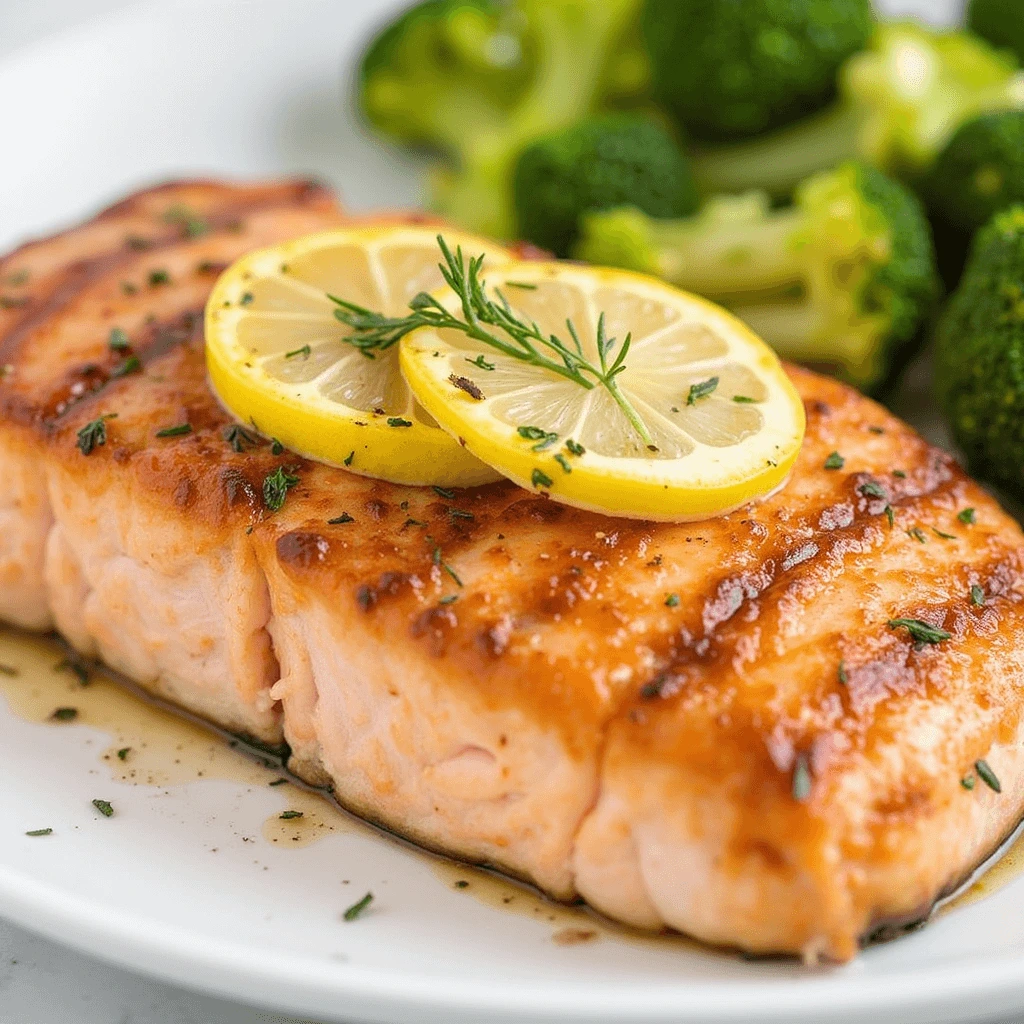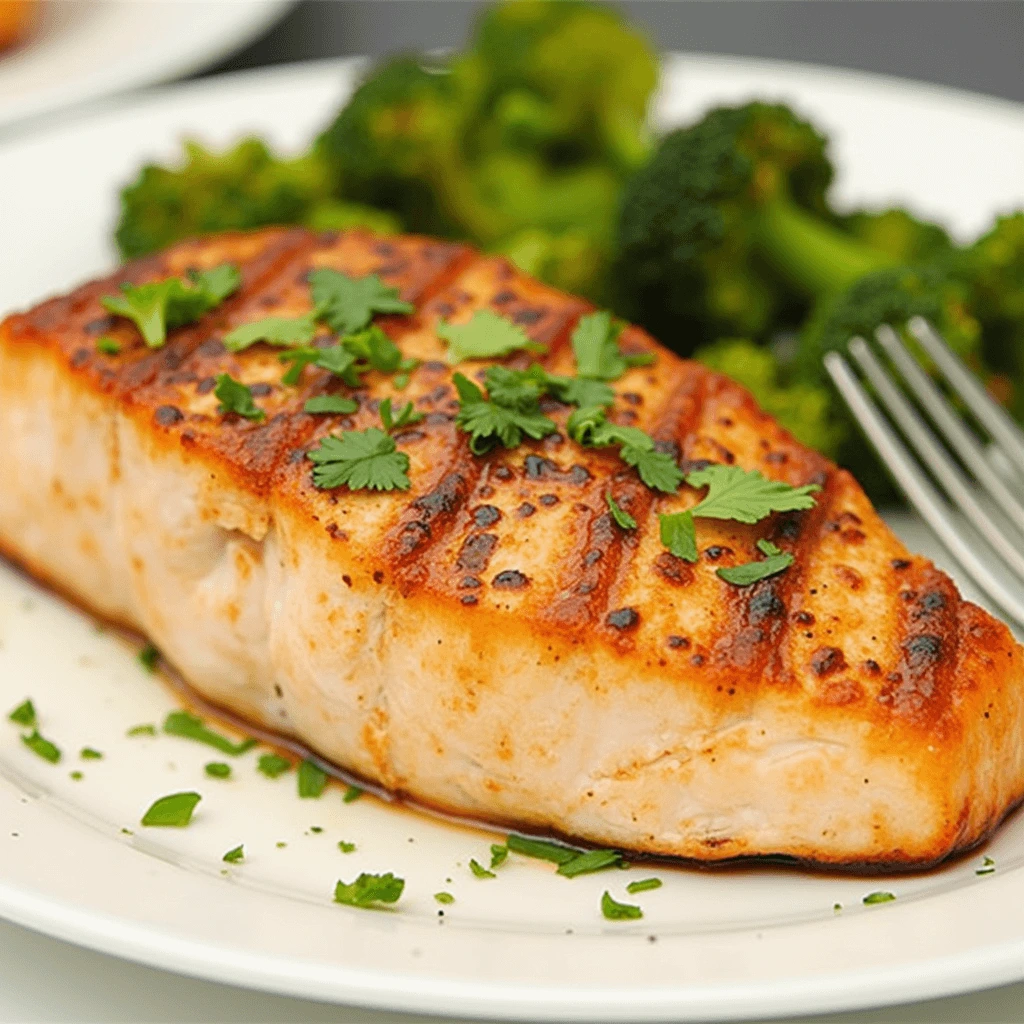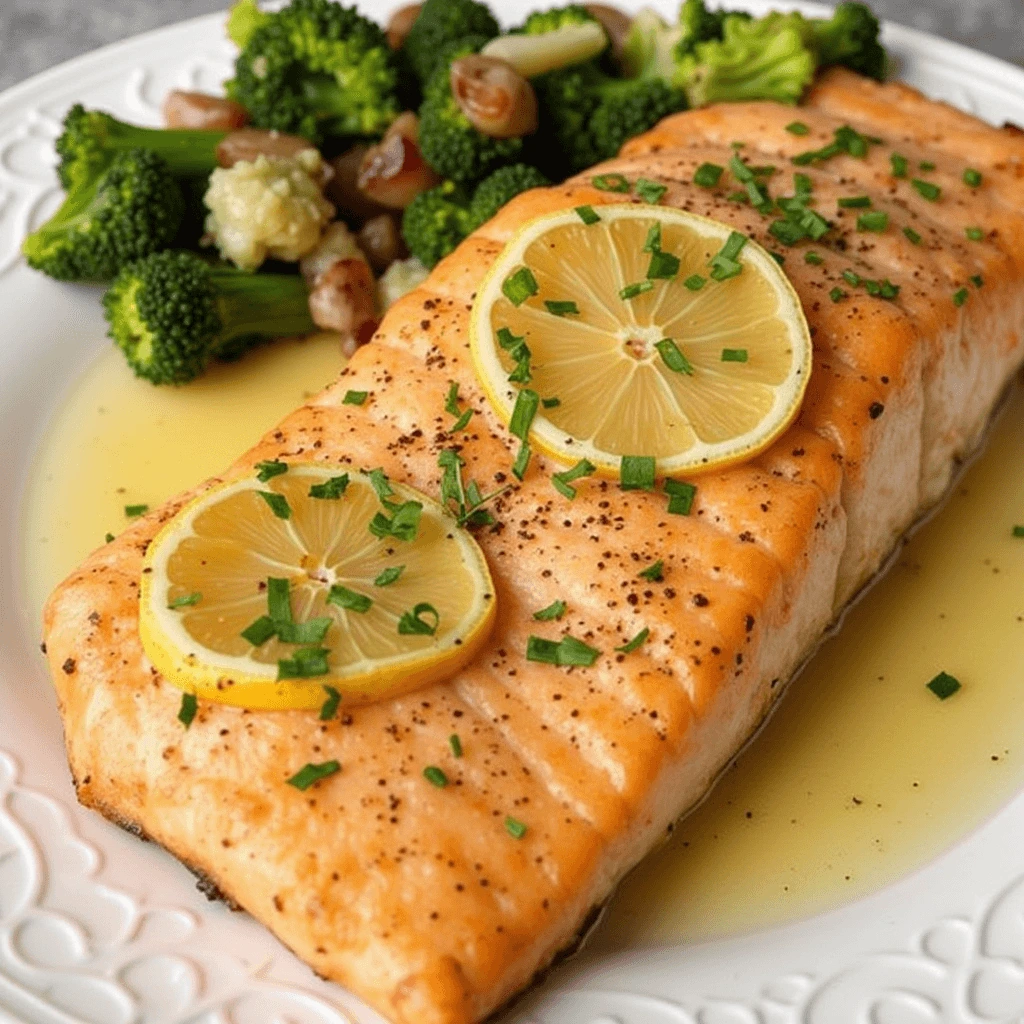Salmon Fish Steak Recipe: Why It’s Your New Weeknight Favorite
Cooking salmon fish steak recipe at home is easier than you might think. Whether you’re a seafood lover or just looking for a quick and nutritious meal, salmon steak is a fantastic choice. Here’s why:
Table of Contents
Quick and Easy – Perfect for Busy Weeknights
One of the best things about salmon steak is how quickly it cooks. Whether you pan-sear it, grill it, or bake it in the oven, you can have a restaurant-quality meal ready in under 30 minutes. No complicated techniques or long preparation times—just a simple, satisfying dish that fits into your schedule.
Nutritious and Packed with Omega-3s
Salmon is both flavorful and packed with essential nutrients. It’s loaded with omega-3 fatty acids, which support heart health and brain function. It’s also a great source of high-quality protein, making it a fantastic option for those looking to eat healthier without sacrificing flavor.
Versatile and Works with Many Cooking Methods
Salmon steak is one of the most versatile proteins you can cook. Prefer a crispy crust? Pan-searing in a hot skillet is the way to go. Love smoky flavors? Grilling gives it that perfect char. Need a hands-off method? Oven-baking with garlic butter ensures a juicy, flavorful result. No matter your cooking style, salmon steak adapts effortlessly.
Customizable with a Variety of Flavors
One of the best parts about making salmon steak at home is that you can customize it to match your cravings. Want a classic lemon-garlic flavor? A drizzle of butter sauce with fresh herbs does the trick. Prefer something bold and tangy? A honey glaze or soy-based marinade adds a fantastic twist. The possibilities are endless, making it easy to enjoy salmon steak in a new way each time.
Ingredients That Make This Dish Irresistible
The secret to an amazing salmon fish steak recipe lies in the quality of ingredients. Choosing the right type of salmon, seasonings, and optional flavor boosters can take this dish from good to unforgettable. Here’s what you need to know:
Choosing the Best Type of Salmon
Not all salmon is the same! The type you choose affects both the flavor and texture of your dish.
- Atlantic Salmon – Mild, buttery, and widely available. Perfect for beginners.
- Pacific Salmon (Sockeye, Coho, or King Salmon) – Richer in flavor with firmer texture. Sockeye has a deep red color and a bold taste, while King (Chinook) salmon is the most luxurious with a high oil content.
- Wild vs. Farmed Salmon – Wild salmon tends to be leaner with a stronger taste, while farmed salmon is fattier and milder. Both work well, depending on your preference.
Essential Seasonings for the Perfect Salmon Steak

A good salmon fish steak recipe doesn’t need a long list of ingredients—just a few simple seasonings can enhance its natural flavor:
- Olive Oil or Butter – Helps create a crispy, golden-brown crust and adds richness.
- Garlic – Freshly minced or in powder form, it brings out deep, savory notes.
- Black Pepper & Sea Salt – Simple but essential for seasoning any fish dish.
- Fresh Herbs (Dill, Parsley, or Thyme) – Adds freshness and depth to the flavor profile.
- Lemon Zest or Juice – Brightens up the dish (optional, if you prefer other citrus alternatives).
Flavor Boosters: Marinades & Sauces
While simple seasonings work well, adding a marinade or sauce can elevate your salmon steak to the next level.
- Garlic Butter Sauce – A luxurious, classic choice that pairs perfectly with salmon’s rich taste.
- Honey Glaze – A slightly sweet and caramelized finish that balances the fish’s natural oils.
- Soy Sauce & Ginger Marinade – Brings in a savory umami depth, great for an Asian-inspired dish.
- Spicy Cajun Rub – Perfect for those who love bold, smoky, and slightly spicy flavors.
Optional Toppings for Extra Texture and Taste
Want to add more excitement to your salmon steak? Try these toppings for extra crunch and flavor:
- Toasted Almonds or Pine Nuts – Adds a nutty crunch.
- Avocado Slices – Creamy and delicious, pairing well with salmon’s buttery texture.
- Mango Salsa – A fresh, tropical twist that adds sweetness and acidity.
Three Simple Ways to Cook Salmon Steak
Salmon Fish is incredibly versatile and can be cooked in multiple ways, depending on your preference. Whether you love a crispy crust, a smoky grilled flavor, or a tender and juicy baked texture, these three easy methods will help you make the perfect salmon steak every time.
Pan-Seared Salmon Steak for a Crispy Crust
Pan-searing is one of the best ways to cook salmon steak if you love a crispy golden-brown crust with a tender, juicy center. It locks in the flavors and gives the salmon a restaurant-quality finish.
How to Pan-Sear Salmon Steak:
- Prepare the salmon: Pat the salmon steak dry with a paper towel to remove excess moisture (this helps with browning).
- Season it well: Rub both sides with olive oil, salt, black pepper, and garlic.
- Heat the pan: Place a cast-iron skillet or non-stick pan over medium-high heat and add a tablespoon of olive oil or butter.
- Sear the salmon: Place the salmon steak in the pan and cook for about 4-5 minutes on one side without moving it. This creates a crispy crust.
- Flip and cook the other side: Gently flip the steak and cook for another 3-4 minutes until the fish is cooked through but still moist inside.
- Finish with butter and herbs (optional): Add a small knob of butter and fresh herbs like thyme or dill to enhance the flavor.
Pro Tip: Let the salmon rest for a couple of minutes before serving to allow the juices to redistribute.
Grilled Salmon Steak for a Smoky, Charred Flavor
Grilling gives salmon a slightly smoky flavor with delicious charred edges. It’s a fantastic option for summer cookouts or when you want a healthy, oil-free method.
How to Grill Salmon Steak:
- Preheat the grill: Heat the grill to medium-high heat (375-400°F / 190-200°C) and oil the grates to prevent sticking.
- Season the salmon: Brush the salmon with olive oil and season with salt, pepper, garlic, and lemon zest.
- Grill skin-side down first: Place the salmon steak skin-side down and grill for 4-5 minutes without moving it.
- Flip and grill the other side: Carefully flip the steak using tongs and grill for another 3-4 minutes until cooked through.
- Remove and serve: Let it rest for a minute before serving with a drizzle of lemon butter or a side of creamy dill sauce.
Pro Tip: If using a gas grill, keep one side on low heat to prevent flare-ups and overcooking.
Oven-Baked Salmon Steak with Garlic Butter

If you prefer a hands-off approach, baking salmon steak in the oven is the way to go. This method keeps the fish moist and flavorful with minimal effort.
Salmon fish Steak Recipe
| Ingredient | Amount |
|---|---|
| 2 salmon steaks | (around 6 oz each) |
| Olive oil | 2 tablespoons |
| Garlic (minced) | 1 clove |
| 1 tsp | dried oregano |
| Dried thyme | 1 teaspoon |
| Salt | Adjust according to taste |
| Pepper | Add to taste |
| Fresh parsley (optional) | 1 tablespoon (chopped) |
| Lemon wedges (optional) | As desired |
Instructions:
| Step | Action |
|---|---|
| 1. Make the Marinade | In a bowl, combine olive oil, minced garlic, oregano, thyme, salt, and pepper. |
| 2. Marinate the Salmon | Coat the salmon steaks evenly with the marinade and refrigerate for 15 to 20 minutes. |
| 3. Preheat the Grill or Pan | Warm up your grill or skillet over medium heat. |
| 4. Cook the Salmon | Cook salmon steaks for 4-5 minutes per side, until flaky and cooked through. |
| 5. Serve | Top with fresh parsley and add lemon wedges on the side, if you like. |
How to Bake Salmon Steak:
- Heat the oven to 400°F (200°C) before you begin.
- Prepare a baking dish: Line a baking sheet with parchment paper or lightly grease a baking dish.
- Season the salmon: Brush the salmon steak with olive oil or melted butter, then sprinkle with salt, pepper, garlic, and fresh herbs.
- Add extra flavor (optional): Drizzle with lemon juice, honey, or soy sauce for extra depth.
- Bake for 12-15 minutes: Place the salmon in the oven and bake until the internal temperature reaches 125-130°F (52-54°C) for a perfect medium doneness.
- Broil for extra crispiness (optional): If you want a crispy top, switch the oven to broil mode for the last 1-2 minutes.
Pro Tip: Avoid overbaking—salmon continues cooking slightly even after removing it from the oven, so let it rest for a few minutes before serving.
Which Cooking Method is Best for You?
- Pan-searing is best for a crispy, flavorful crust and quick cooking time.
- Grilling adds a smoky, charred taste and is great for outdoor cooking.
- Oven-baking is the easiest method for juicy, tender salmon with minimal effort.
Each method brings out different textures and flavors, so try them all and see which one you love the most!
Delicious Sides to Pair with Your Salmon Fish Steak
A perfectly cooked salmon steak deserves equally delightful side dishes. Whether you prefer light and healthy options, comforting classics, or flavor-boosting sauces, the right sides will elevate your meal to the next level.
Healthy and Light Side Dishes to Complement Your Salmon
If you want to keep things fresh and nutritious, these sides will perfectly balance the richness of your salmon fish steak recipe:
- Roasted Asparagus with Garlic – A light, savory veggie option that complements the flavors of your salmon.
- Sautéed Spinach with Lemon – A quick and healthy green side that adds vitamin-packed goodness.
- Quinoa Salad with Fresh Veggies – A protein-packed grain salad, perfect for a light yet filling meal.
- Cauliflower Rice – A low-carb alternative that absorbs the flavors of your salmon’s seasoning.
- Grilled Zucchini or Bell Peppers – Slightly smoky and slightly sweet, these veggies pair wonderfully with grilled salmon.
Pro Tip: Drizzle with balsamic glaze over roasted vegetables for an extra layer of sweetness.
Comforting Side Dishes for a Hearty Salmon Meal
For those who want a heartier meal, these comforting sides are the perfect match for your juicy salmon steak:
- Creamy Garlic Mashed Potatoes – Buttery mashed potatoes with a garlic kick that enhance the richness of the salmon.
- Herbed Rice Pilaf – A fragrant rice dish with fresh herbs and butter that balances out the salmon’s bold flavor.
- Oven-Roasted Baby Potatoes – Crispy on the outside and soft on the inside, seasoned with rosemary for extra flavor.
- Creamy Polenta with Parmesan – A smooth, cheesy side that adds richness and complements the delicate salmon texture.
- Linguine with Garlic Butter or Pesto Sauce – Light pasta tossed in a savory sauce makes for a perfect salmon side.
Pro Tip: If your salmon has a rich or buttery sauce, go for lighter sides like a citrus salad or roasted vegetables to keep the meal balanced.
Flavor-Enhancing Sauces and Toppings for Salmon Steak
A great sauce can take your salmon fish steak recipe from good to unforgettable. These sauces and toppings will add extra layers of flavor:
- Lemon Garlic Butter Sauce – A classic and easy sauce to bring out the natural flavor of your salmon.
- Creamy Dill Sauce – Made with Greek yogurt or sour cream, this sauce offers a tangy, herby touch.
- Mango Salsa with Lime – A refreshing topping that adds sweetness and acidity to contrast the richness of the fish.
- Honey Mustard Glaze – A tangy-sweet sauce that caramelizes beautifully, perfect for grilled or baked salmon.
- Spicy Sriracha Mayo – If you like heat, this creamy, spicy topping adds bold flavor to your salmon.
Pro Tip: If your salmon is already marinated with bold flavors, keep the sauce simple, such as a lemon butter or olive oil drizzle, to let the fish shine.
Bright and Refreshing Salad Pairings for Salmon Fish Steak
Fresh salads not only add a crunch but also help balance the richness of your salmon dish. Here are some ideas:
- Citrus Avocado Salad – Arugula, grapefruit, and avocado combine for a bright and tangy contrast to the salmon.
- Mediterranean Cucumber and Tomato Salad – A cool, crisp salad with feta cheese and olives that pairs perfectly with grilled or baked salmon.
- Classic Caesar Salad – Crunchy romaine with a creamy dressing, perfect for those who love the classic combo.
- Asian-Inspired Slaw with Sesame – A crunchy, tangy cabbage slaw that adds an extra pop of flavor.
Pro Tip: For added texture, top your salad with toasted nuts or seeds that complement the softness of the salmon.
How to Choose the Right Side for Your Salmon Steak

- Pair your grilled salmon with grilled veggies, roasted potatoes, or a bright salad.
- If your salmon is pan-seared, serve it with creamy mashed potatoes, quinoa, or polenta.
- For oven-baked salmon, try rice pilaf, steamed greens, or roasted asparagus.
These combinations will give you a satisfying and well-rounded meal, with the perfect side to complement your salmon steak’s flavors.
Pro Tips for Cooking Salmon Like a Chef
Cooking salmon fish steak recipe might seem simple, but a few key tips can take your dish from good to gourmet. These pro tips will help you achieve flawless texture, rich flavor, and that restaurant-quality finish every time. Let’s dive into the tricks that professional chefs swear by!
Choose Fresh, High-Quality Salmon for the Best Results
The foundation of a great salmon fish steak recipe starts with the quality of the fish. Consider these factors when choosing the perfect salmon:
- Freshness is Key – Always buy the freshest salmon available. Look for fish with bright, vibrant color (red to orange), and the flesh should be firm and moist. It should smell mildly of the sea—not fishy.
- Wild-Caught vs. Farmed – Wild-caught salmon tends to have a stronger flavor and a leaner texture, while farmed salmon is fattier and milder. Both have their place in cooking, but wild-caught tends to offer a more natural taste.
- Bone-In vs. Boneless – While boneless cuts are easier to handle, bone-in salmon steaks have more flavor, as the bones contribute to the richness of the fish during cooking.
- Thickness Matters – For even cooking, try to choose salmon steaks that are of uniform thickness. This helps the fish cook evenly and ensures you get a perfect medium-rare center.
Pro Tip: If buying frozen salmon, choose flash-frozen over thawed fish. It maintains its freshness and texture better than thawed fish, which can degrade more quickly.
Don’t Overcook Your Salmon – Aim for Medium-Rare
A frequent error when preparing salmon is cooking it for too long. It’s easy to do, but it leads to dry, chewy fish. Here’s how to achieve the perfect doneness:
- Internal Temperature – For medium-rare salmon, the internal temperature should reach around 120-125°F (49-52°C). At this temperature, the fish remains moist and tender, with a slightly translucent center.
- Use a Meat Thermometer – To ensure perfect doneness, invest in a digital meat thermometer. It’s a simple tool that guarantees precise cooking every time.
- Rest After Cooking – Let your salmon rest for a few minutes after cooking. This helps retain the moisture, ensuring the fish stays tender and doesn’t dry out.
Pro Tip: If you like your salmon on the slightly firmer side, aim for 130°F (54°C) for a more well-done texture, but be careful not to go higher than that or it will dry out.
Master the Art of Seasoning Your Salmon
While salmon has a naturally delicious flavor, the right seasonings can enhance it without overpowering it. Here’s how to use seasonings effectively:
- Keep It Simple – Salmon doesn’t need a lot of fancy ingredients. Just salt, pepper, and a drizzle of olive oil or melted butter can do wonders. The key is to let the fish’s natural flavor shine.
- Herbs & Aromatics – Fresh herbs like dill, thyme, or parsley pair beautifully with salmon. Adding crushed garlic or shallots enhances the savory profile.
- Marinades and Rubs – Marinate your salmon for 15-30 minutes before cooking for extra flavor. A simple marinade of soy sauce, garlic, and honey works wonders. For a spicy kick, use a Cajun rub or paprika.
- Citrus – Lemon and lime both enhance the flavor of salmon, whether you’re using zest or juice. You can either marinate the fish in citrus or use it as a finishing touch after cooking.
Pro Tip: Don’t add salt too early in the cooking process, as it draws moisture out of the fish. Instead, season just before or immediately after cooking to keep the salmon juicy.
Use the Right Cooking Method for Your Desired Texture
The cooking method you choose can dramatically affect the texture of your salmon steak. Here are some tips for mastering each technique:
- Pan-Seared Salmon for Crispy Skin – If you love a crispy skin, pan-searing is the way to go. Start with a hot pan and cook the salmon skin-side down to lock in moisture.
- Grilled Salmon for Smoky Flavor – Grilling adds a beautiful charred flavor that complements salmon’s rich taste. Make sure the grill is preheated to medium-high heat, and oil the grill grates to prevent sticking.
- Baked Salmon for Tender Flakes – Baking is a foolproof method for perfectly tender, moist salmon. A low, even heat ensures the fish cooks gently without drying out. Wrap the fish in foil or parchment paper to keep it moist during baking.
- Poaching for Silky Texture – Poaching salmon in broth or wine creates a silky, melt-in-your-mouth texture. Simply simmer the fish in the liquid until cooked through (about 15-20 minutes, depending on thickness).
Pro Tip: For an extra layer of flavor, add fresh herbs and aromatics like garlic and shallots to the poaching liquid.
Let Your Salmon Rest and Serve It Right
Just like any other meat, letting your salmon rest after cooking is essential. This simple step ensures that the fish stays moist and juicy. Here’s how to serve it like a pro:
- Resting Time – Let the salmon rest for 3-5 minutes after cooking to allow the juices to redistribute evenly throughout the flesh.
- Serving Ideas – Serve your salmon steak on a warmed plate to maintain its temperature. Garnish with fresh herbs, a drizzle of sauce, or a slice of lemon for an elegant finish.
- Cut with the Grain – When slicing salmon for serving, cut against the grain to ensure clean, tender pieces.
Pro Tip: If you’re preparing a salmon platter, arrange the fish with complementary sides, sauces, and garnishes to make it look as good as it tastes!
Conclusion
Salmon fish steaks are a flavorful, nutritious, and easy-to-make dish that can elevate any meal. With their rich taste and tender texture, they pair beautifully with a variety of sides, making them perfect for both casual dinners and special occasions. Whether you choose to grill, pan-sear, or bake your salmon, the key to a perfect fish steak lies in choosing fresh ingredients and seasoning it well. Follow the simple steps in this recipe to enjoy a delicious and healthy meal packed with omega-3s, protein, and essential vitamins. So, grab your salmon steaks, get cooking, and savor the vibrant flavors of this tasty dish!

